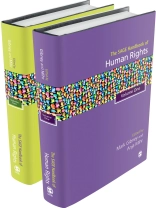The SAGE Handbook of Human Rights will comprise a two volume set consisting of more than 50 original chapters that clarify and analyze human rights issues of both contemporary and future importance. The Handbook will take an inter-disciplinary approach, combining work in such traditional fields as law, political science and philosophy with such non-traditional subjects as climate change, demography, economics, geography, urban studies, mass communication, and business and marketing. In addition, one of the aspects of mainstreaming is the manner in which human rights has come to play a prominent role in popular culture, and there will be a section on human rights in art, film, music and literature.
Not only will the Handbook provide a state of the art analysis of the discipline that addresses the history and development of human rights standards and its movements, mechanisms and institutions, but it will seek to go beyond this and produce a book that will help lead to prospective thinking.
विषयसूची
Part I: Theoretical Issues and Methodology
Chapter 1: Human Rights Research and Theory
Chapter 2: Pleading for a New History of Human Rights
Chapter 3: Universalism and Relativism
Chapter 4: Governance and Human Rights
Chapter 5: Mainstreaming Human Rights: Assessing the Impact of Sixty Years of International Human Rights Law
Chapter 6: The Interaction between International Humanitarian Law and International Human Rights Law
Chapter 7: International Relations Theories and Human Rights
Chapter 8: The Two Covenants and the Evolution of Human Rights
Chapter 9: Physical Integrity and Human Rights
Chapter 10: Human Rights Measurement
Chapter 11: Social Science, Methods and Human Rights
Part II: Norms and Standards
Chapter 12: Asymmetric Non-International Violent Conflicts: Challenges to the Protection of Human Rights
Chapter 13: National Security, Counter-terrorism and Human Rights: Anticipating the real threat of terrorism
Chapter 14: Climate Change and Human Rights
Chapter 15: Migration, Refugees, Asylum and Uprooted Peoples’ Rights
Chapter 16: The Human Rights of Persons with Disabilities
Chapter 17: The Human Rights of Gays, Lesbians, Bisexual and Transgender People
Chapter 18: Human Rights, Women and Gender
Chapter 19: Inclusion versus Exclusion
Chapter 20: Human Rights Defenders and Activism
Chapter 21: Non-state actors (NSAs) in human rights promotion
Chapter 22: Business, Trade and Human Rights
Chapter 23: Communication and New Technology
Part III: Human Rights in Popular Culture
Chapter 24: Making Human Rights Visible through Photography and Film
Chapter 25: Human Rights and Art
Chapter 26: Human Rights in Literature
Chapter 27: States, Superheroes and Storytellers: Human Rights Through Comics and Graphic Novels
Chapter 28: Music and Human Rights
Chapter 29: Human Rights and Celebrities
Chapter 30: Human Rights in International Sports
Part IV: Human Rights Mechanisms
Chapter 31: The United Nations Human Rights System: The Genesis and Role of the Human Rights Council and the High Commissioner for Human Rights
Chapter 32: The African Regional Human Rights System
Chapter 33: The Inter-American System of Human Rights
Chapter 34: The League of Arab States and Human Rights
Chapter 35: Human Rights Systems in the Asia-Pacific
Chapter 36: European Human Rights System
Chapter 37: The European Convention on Human Rights and the Protection of Socio-Economic Demands
Chapter 38: National Human Rights Institutions
Chapter 39: Human Rights Cities
Part V: Global Justice and Accountability
Chapter 40: The Extension and Legalization of Human Rights
Chapter 41: Domestic Courts and International Human Rights
Chapter 42: Human Rights in Accountability Processes: A Look at Ad Hoc Hybrid Criminal Courts
Chapter 43: International Jurisdiction
Chapter 44: From Humanitarian Intervention to the Responsibility to Protect: Old Wine in a New Bottle or the Progressive Development of International Law?
Part VI: Peace, Reconciliation and Sustainability
Chapter 45: Awareness, Learning and Education in Human Rights
Chapter 46: “Fact-Based Storytelling” or Fact-Based Activism?: Tensions, Strategies and Next Steps of Human Rights and Journalism
Chapter 47: Prevention and Human Rights
Chapter 48: Peacebuilding and Human Rights
Chapter 49: Transitional Justice and Human Rights
Chapter 50: Human Rights, Memory and Reconciliation: Korea-Japan Relations
Part VII: People, Power and Property
Chapter 51: People’s Power and Participation
Chapter 52: Human Right to Development
Chapter 53: Intellectual Property Rights
Part VIII: Future Directions
Chapter 54: Social Change and Human Rights
Chapter 55: Universal Human Rights and States’ International Responsibility
Chapter 56: The Environment and Human Rights
Chapter 57: Reconceptualizing Human Rights Duty-Bearers
लेखक के बारे में
Anja Mihr (Ph.D.) is DAAD Associate Professor at the OSCE Academy in Bishkek, Kyrgyzstan, for Human Rights, Governance, Public Policy and Transitional Justice. She is the Founder and Program Director of the HUMBOLDT-VIADRINA Center on Governance through Human Rights in Berlin in Germany. She has held professorships at the Willy-Brandt School of Public Policy, Erfurt University, Germany and at the Netherlands Institute of Human Rights (SIM), University of Utrecht, Netherlands. Mihr has been Head of the Rule of Law department at The Hague Institute for Global Justice and carried out a number of Visiting Professorships for Human Rights and Public Policy such as at Peking University Law School in China, as well as at SIPA, Columbia University in New York. Anja Mihr was the European Program Director for the European MA Degree in Human Rights and Democratization (E.MA) at the Global Campus for Human Rights, Italy. She received her Ph.D. in Political Sciences from the Free University in Berlin, Germany, in 2001. She has published several books and articles on international human rights regimes and law, human rights education, transitional justice, and Civil Society Organizations and has been editor of the two-volume International Handbook of Human rights and the European Yearbook of Human Rights, the German Journal for Human Rights, the OSCE Academy annual book series in Transformation and Development in the OSCE region.












